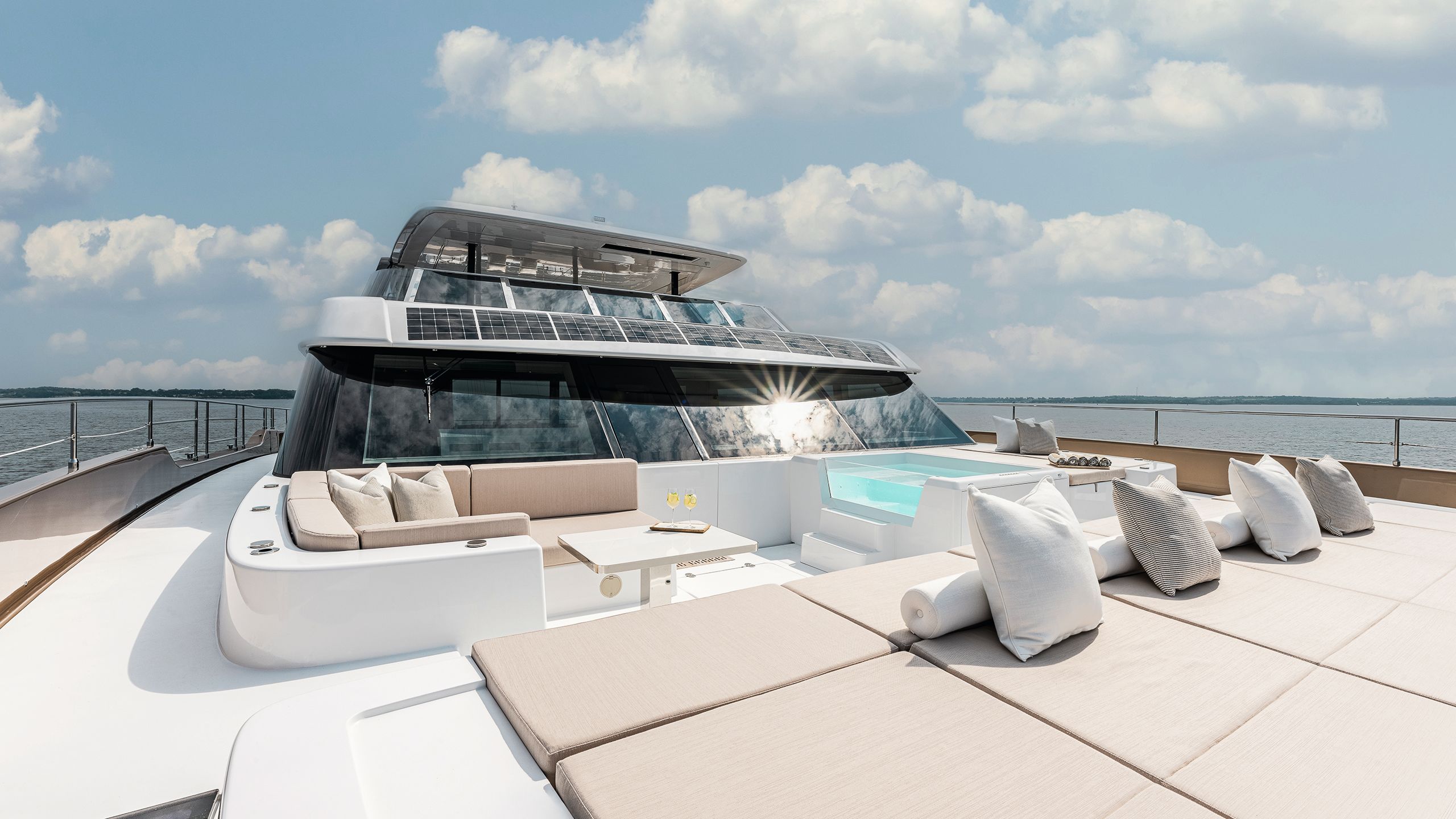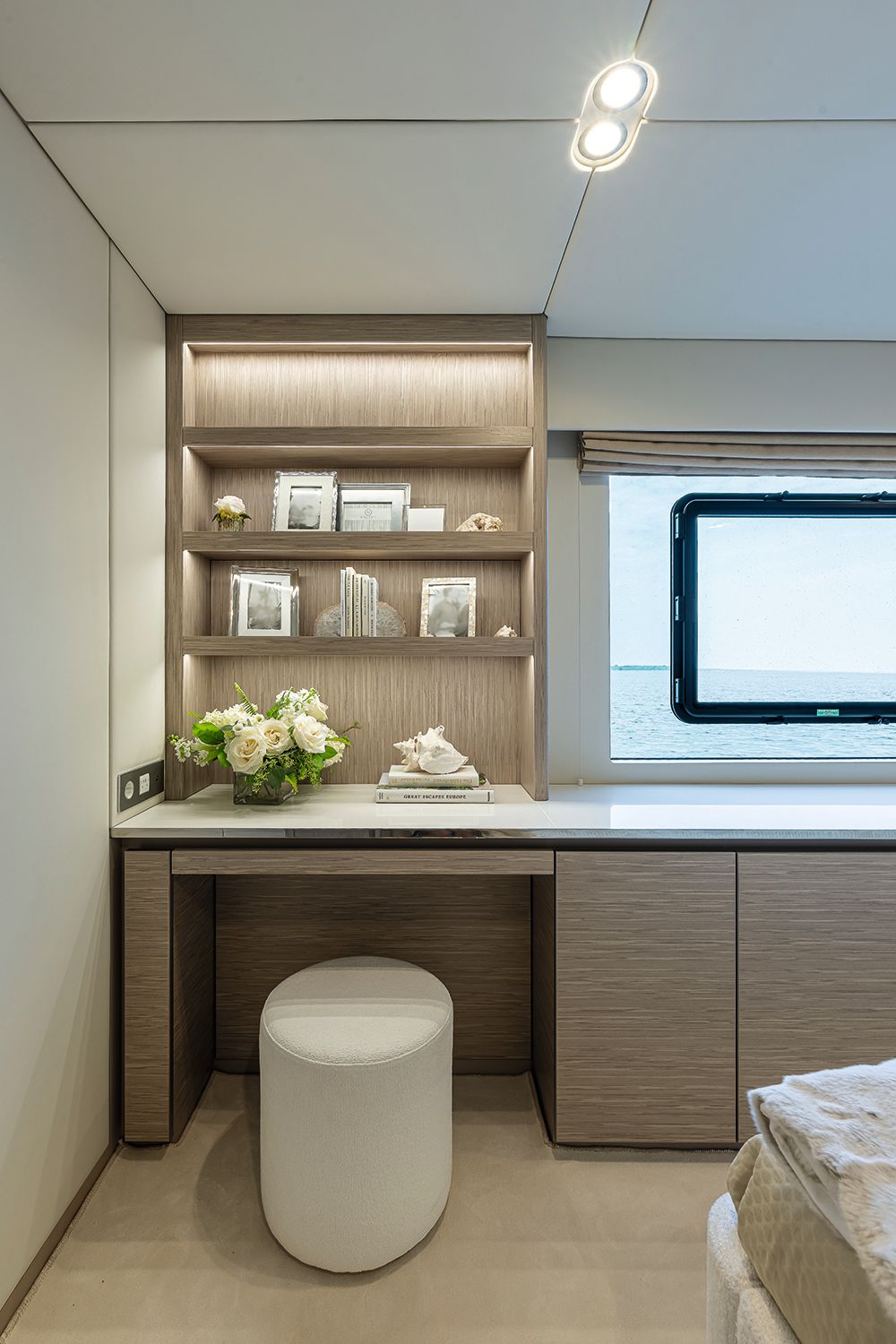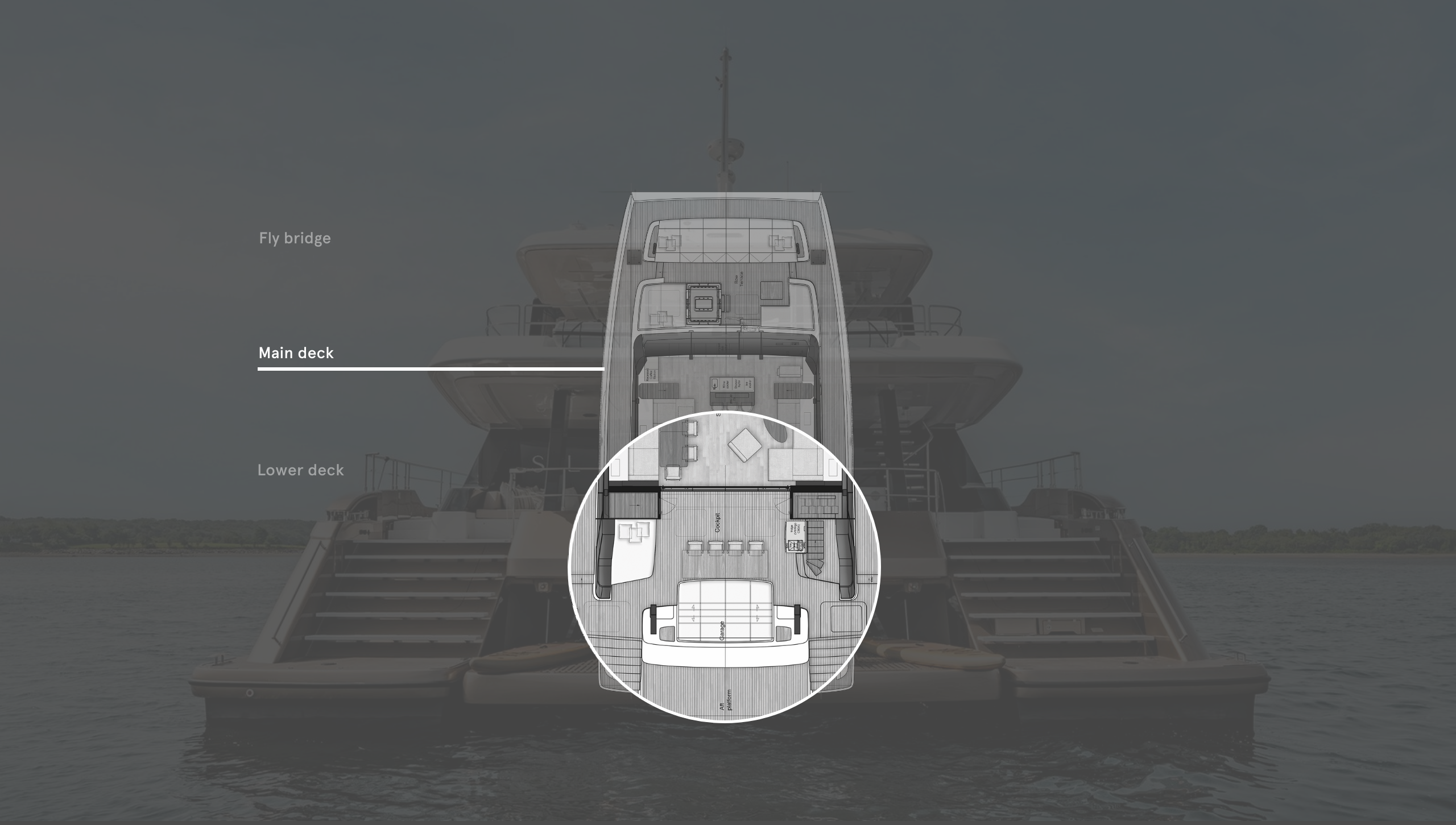SUNNY SIDE UP
On board the first unit in Sunreef's 80 Power Eco series

No fumes, no animal products and acres of space, the Caribbean-friendly Sunreef SÓL wows Kevin Koenig with its innovations
Hanging in the Herreshoff Marine Museum in Bristol, Rhode Island, is one of the first catamarans ever built in the Western world.
Brothers John and Nathanael Herreshoff drew inspiration from the seaworthy Polynesian ama that dates to antiquity to design the little cat as the hotrod of its day. It won so many sailing races that it was eventually outlawed from competition, as its technology far outpaced its peers.

CREDIT The owner of SÓL chose to place the Jacuzzi on the bow terrace instead of on the flybridge
CREDIT The owner of SÓL chose to place the Jacuzzi on the bow terrace instead of on the flybridge
The parallels were not lost on me as I walked down the docks a stone’s throw from the museum toward the Sunreef 80 Power Eco SÓL.
This catamaran uses solar-electric propulsion to sail with a vastly minimised carbon footprint, and its entire ethos – from the avant-garde propulsion technology to the non-toxic bottom paint to the vegan meals prepared in its galley – centres around a level of green-conscientiousness that may very well be unrivalled in the yachting world.

For the owner, that was the whole point. “We had more traditional motor yachts in the past but we took a little break,” he says, “and we wanted to get back into yachting but didn’t feel great about having a large diesel power yacht.
“We had all moved on from traditional transportation with our cars years ago, and we were invested in green in other sectors like food and ag. The family all started looking and they bombarded me with articles about electric yachts, and that’s kind of how it all started.

“But what we really want to do is accelerate change in the industry by showing people what’s possible. This is the most advanced electric cat in the world, and it will catalyse real change by being available for charter so people can see what it’s about and be in the boat shows, like down in Lauderdale this year.”

__The yacht’s photovoltaic panels also serve an aesthetic function, making a striking contrast with the hull’s golden color
__The yacht’s photovoltaic panels also serve an aesthetic function, making a striking contrast with the hull’s golden color
Of course, wanting a large green power yacht and building one are two different things, but Sunreef Yachts was up to the challenge. SÓL is the largest vessel in the builder’s nearly 10-year-old Eco line, and its one-megawatt battery bank is the largest in the world for a vessel under 24 meters (79ft), according to the builder.

“What we really want to do is accelerate change in the industry by showing people what is possible”
“We are a family company,” Nicolas Lapp, Sunreef ’s co-founder, says. “It’s me and my father, so if a customer comes to us with an interesting idea like a solar-powered boat, we don’t need to do the risk calculations or worry about shareholder value, we just pick up the phone and say ‘Alright, let’s do it,’ and it gets done.”
Building a boat like this did produce some unique challenges for the builder, which is located in Gdańsk, Poland. “The most challenging part for us, building as ambitious a project as a boat like this, is getting all of our 2,500 employees to understand the quality we expect from the finished product,” Lapp says.


An al fresco dining settee on the flybridge provides an excellent place to take in those Virgin Island breezes. Right: the bar behind the helm is a great viewing spot underway
Beyond that, the solar panels themselves created not just an engineering challenge but an aesthetic one too.
“We checked the market and found that [existing] solar panels don’t work that well unless the boat is designed specifically for them,” Lapp says.
“Flexible panels don’t work like we need them to, they have to be flat, but that of course affects the exterior design and we want our boats to look nice. We ended up designing our solar panels ourselves so they would be strong, efficient and lightweight.”
“We can sit out with the engines running and it’s completely quiet, and you don’t get those fumes while you’re trying to enjoy your morning coffee”

SÓL is the sixth boat in Sunreef ’s Eco line to make use of the technology, but it uses more of it than any other model. The 2,000 square feet of proprietary, 0.04-inch-thick photovoltaic skin wrapped around much of the yacht was necessary to operate that massive battery bank.

The other main challenge, Lapp says, was designing a vessel that would require less of the power output they could generate.
“We are using 4 to 5kW per hour to run air conditioning, water heating systems and the like, so we spent a lot of time learning how to compress those systems to make them as efficient as possible because, in the end, it’s an equation of balance. If what you use is as minimal as possible, that means you need less energy to begin with.”

__It’s hard to understand the sheer size of a 24-metre cat. The captain says owners of 36-metre boats have been blown away by the 2,000 sq ft of interior space when stepping aboard
__It’s hard to understand the sheer size of a 24-metre cat. The captain says owners of 36-metre boats have been blown away by the 2,000 sq ft of interior space when stepping aboard
Aiding these power demands is a bank of batteries that have a density of less than 11.6 pounds per kWh, which means they are significantly lighter than previous batteries. They power twin 360kW motors that give the yacht a 300-nautical-mile range under batteries and solar alone.
That range may strike some as paltry for a 24-metre catamaran, but without diesel engines, it’s about the best you can find. And anyway, this yacht is largely designed for island hopping in the Caribbean and bluewater voyages aren’t in the cards.
For the owner, the trade-off is worth it. “One of the things I really don’t miss about a diesel-powered yacht are the fumes,” he says. “On this boat, we can sit out in the cockpit with the engines running, and one, it’s completely quiet, and two, you don’t get those fumes kicking up right in your face while you’re trying to enjoy your morning coffee. It’s such a better way to boat.”

The owners and family have plenty of other places to lounge in comfort beyond the aft deck, too. What struck me most about this Sunreef, even more so than its unconventional propulsion system, was its saloon.
Unless you’ve been aboard a 24-metre catamaran, it’s difficult to imagine just how expansive the onboard space is. The owner asked Sunreef and interior designer Kevin OBrien of the OBrien Design Group in Massachusetts to make the saloon “Nantucket-y and Balinese-y,” and they delivered.
The saloon is open-concept and done in whites, creams and light greys that imbue it with a feel that is beachy without being too casual and modern without being cold.


Intricate stitching in the leather wraps on the handrails speaks to the high level of fit and finish seen throughout
The owners are dedicated to and invested in the vegan food scene, and there isn’t a single animal product on board SÓL; no leather, no fur, no wool – it’s all synthetic but done in a way that makes it near impossible to tell.
When I walked into the owner’s stateroom, I saw a throw on the bed and lightly touching it, I asked the owner if it was chinchilla. You could have heard his smirk in Gdańsk. “No, it’s faux,” he replied.




The extra privacy offered by a catamaran when it comes to accommodations is perfect for charter. There are two guest cabins in each hull, including a king-berth master
From the saloon, sliding doors open to an al fresco dining table overlooking the massive hydraulic swim platform, which holds a 5.2-metre Carbon Craft tender.
The choice of this flashy tender is in line with the owners’ forward-thinking mantra, and there’s a pragmatic reason as well. It’s light. Without giant diesels rumbling away in its belly, the catamaran is fairly lightweight with a relatively scant displacement of 198 tonnes.
You feel that lightness in other places. For example, the bounciness of a faux-teak grate on the swim platform caught me by surprise. It is something prospective buyers should be prepared for when they get aboard.
DUBAI SUN

Sunreef is ramping up a second factory in Dubai that already has 140 workers as of press time, with plans to hire 800 more. The workforce will be a mix of locals and Poles, who will have use of six CNC machines to help them build Sunreef models, including the 44, 55, 66, 77, and 88.
“Dubai is a good fit for us,” says Sunreef’s Nicolas Lapp. “It attracts talent. I spoke with a naval architect the other day who has worked with the top builders in the world, and he was very excited about moving to Dubai for the lifestyle.
“A guy like that won’t go to Poland. Dubai to me is like the Bahamas of Europe.”
Lapp also points to the speed of business in Dubai as a tempting proposition. “We built that factory in a year,” he says. “In Poland it would have taken four. We can’t wait that long; to take advantage of the opportunity we have to act quickly.”
To date the builder has sold 27 hulls to be built in Dubai.
The 80 Eco’s exterior entertainment areas enjoy the same beamy benefits as the saloon. The foredeck lounge has a Jacuzzi. That’s a customisation; it normally would be on the flybridge.
Massive stowage compartments below the sunpad on this deck will be a boon for scuba lovers as they are an excellent place to stow tanks and dive compressors. With a beam of 11.5 metres, the space offers numerous areas for conversation, and it is very private due to the high freeboard.
But if you’d like an even higher perch, the flying bridge is another attractive option with more sunpads, a barbecue, a dining table and a small bar with three stools. It’s the perfect place to enjoy a beverage while being caressed by tropical breezes as the 80 pulls into port.
At that helm sits Captain Jack Gorman, a sailingcat veteran working on his first powerboat. “I moved to Gdańsk to oversee construction, got an apartment and everything,” he says.
“The technology on board is just so advanced, it is what I felt I had to do to understand it. And the outcome is simply amazing. There’s no smoke when you start the engines. You just pull a knob and it starts up. And it’s so smooth and so silent. This boat feels much more like a sailing vessel than a diesel-powered yacht.”

A transformer serves as a tender launch and also becomes part of this boat’s impressive beach club when lowered
A transformer serves as a tender launch and also becomes part of this boat’s impressive beach club when lowered
My interview with the captain, which occurred at the 2023 Fort Lauderdale Boat Show, was cut short as the saloon swelled with people wanting to get a closer look at this unique vessel and pick the captain’s brain.
Captain Gorman fended them off for as long as he could until a Sunreef executive got his attention. He turned to me with an expression I recognised as the countenance of a true believer.
“I just want to say this,” he said. “When I am on this catamaran, I feel like I am at the forefront of technology in the marine industry – this boat, right here, right now.” He then melted into the sea of people who had come to see history being made.








More solar panels, all developed by Sunreef, cover the hulls sides and flybridge hardtop
There’s 1,750 sq ft of outdoor living space on this vast cat
A door to port of the helm gives quick access to the bow terrace
The aft deck sunpad has an adjustable backrest to make a bench seat for dining
Extra crew can sleep in the forepeaks
The owner’s cabin includes a folding treadmill
LOA 24.3m | Gross tonnage |
LWL 23.5m | Engines |
Beam 11.5m | Generators |
Draft | Speed (max/cruise) |
Range at 8 knots | Owners/guests 8 |
Fuel capacity Freshwater capacity | Crew 4
|
Tender | Certification |
Naval architecture | Interior design |
Exterior styling | Builder/year |
For charter | |
First published in the March 2024 issue of BOAT International US Edition. Get this magazine sent straight to your door, or subscribe and never miss an issue.

